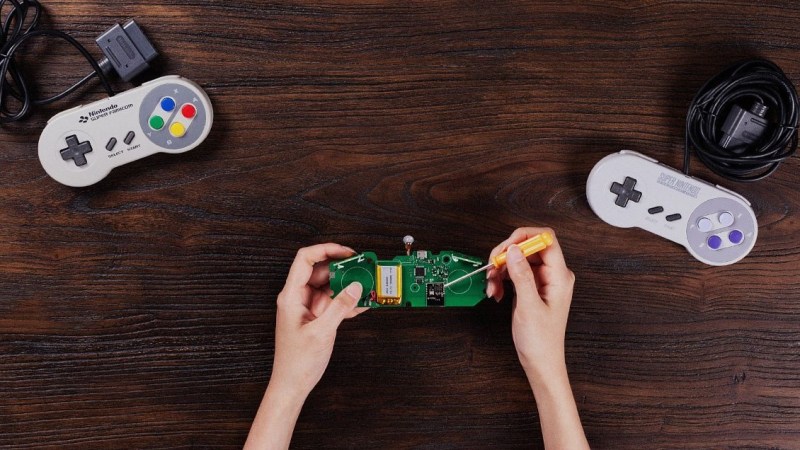Known for their build quality and low latency, the [8bitdo] line of Bluetooth controllers are generally well liked among classic videogame devotees. They match modern conveniences like rechargeable batteries and Bluetooth connectivity with old school color schemes and the tried-and-true feel of a D-pad. All of their current offerings are modeled to invoke the same feel of console controllers of the past, however, for some there is no substitute for the original. For that type of hobbyist, the company created DIY Bluetooth mod kits in the form of drop-in replacement PCBs.
 The featured mod kits are for the original NES controller, SNES controller, and 6-button Genesis Controller. They feature a 180 mAh Li-ion battery for an estimated 7.5 hours of gameplay, and a unique barrel plug type USB charging cable. The charging port fills the void left by the controller’s connection cable and also doubles a the LED status indicator. Though for the Sega Genesis mod kit, the charge port changes to a standard micro USB.
The featured mod kits are for the original NES controller, SNES controller, and 6-button Genesis Controller. They feature a 180 mAh Li-ion battery for an estimated 7.5 hours of gameplay, and a unique barrel plug type USB charging cable. The charging port fills the void left by the controller’s connection cable and also doubles a the LED status indicator. Though for the Sega Genesis mod kit, the charge port changes to a standard micro USB.
The [8bitdo] website boasts compatibility across Android, Linux, Mac, and Windows (drivers permitting) and even Nintendo Switch. With the addition of one of the company’s Retro Receivers, you are able to use the controllers on the original NES or SNES alongside their contemporary NES/SNES classic console counterparts.
So now you can play all those vintage games wirelessly without the need for direct line-of-sight like the old infrared controllers of the 90s. The whole installation process for the PCB is further simplified, because the [8bitdo] mod kits even provide the screwdriver…how thoughtful.
For a more bespoke approach to adding Bluetooth to a classic controller, check out this NES controller mod. Or check out 8bitdo’s tutorial video for the NES Original mod kit:
















wireless charging could’ve made this conversion kit just perfect
I’m sure all devices will eventually get there, but battery life on these controllers is pretty good considering the price.
What’s a good device as far as wireless charging is concerned? I’d like to try one of the good ones. The Qi pad that came with my phone just sucks. You gotta coddle it and it’s super finicky, often results in awakening to find that the phone hadn’t charged overnight, so the cable came back.
OMG if they do this for Official Gamecube controllers….
Where there’s a will, there’s a way.
There was a wireless gamecube controller though.
Yeah, Wavebird. Used proprietary wireless signal and didn’t have rumble though.
Not bluetooth and the batteries didn’t last very long (or I just played too much with it).
I wonder when it becomes worthwhile to produce new plastics that these boards can fit into.
For those with more of a DIY inclination, alot of the parts seem like they could be made via some combination of printing and casting (though you would sacrifice surface feel). The hard part would seem to be the rubber components.
Maybe there is a market for a kit containing STL files for printable parts, molds for casting plastics that are more difficult to print, and the rubber buts that can’t be produced via printing or casting.
What would be the point? If you’re producing significant quantities of molds and rubber parts, you’re already paying for injection molding tools for those — make parts instead of molds, and add another couple tools for the printable parts, and sell a whole kit of actual parts.
Just buy the completed 8bitdo controller then. Making a controller ‘feel’ good is a very underappreciated task, and 8bitdo is one of the only non OEM that does it well.
if only there’s a way i can convert my USB wired mouse to be a wireless mouse.
hope they will have a kit soon!